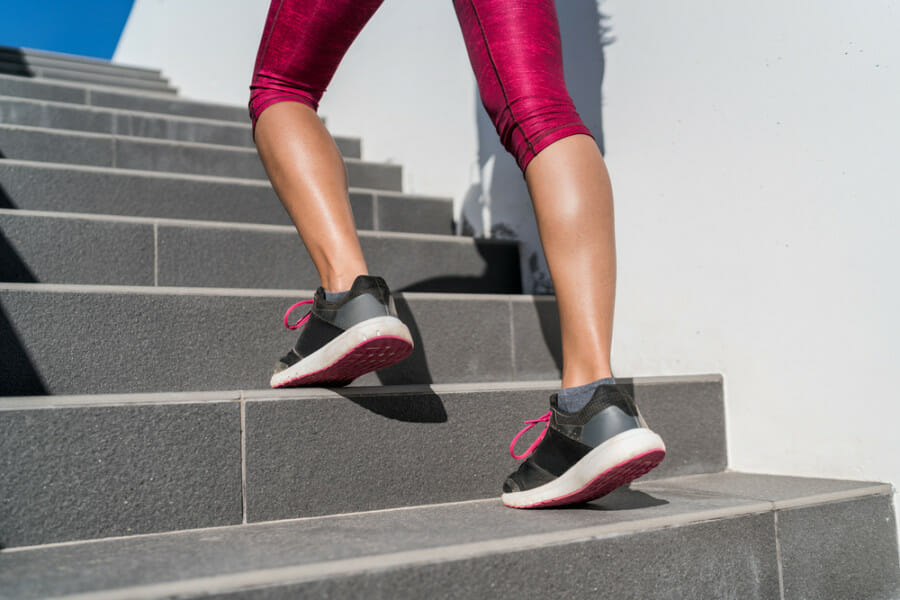5 Best Ways To Use Staircase As A Full-Body Workout
So often, we’re made to believe that we need to invest in high-quality fitness equipment or expensive gym memberships to get truly heart-pumping workouts. In reality, you can achieve a pretty stellar cardio pump and even seriously strengthen muscles by simply rethinking a very common at-home feature. Can you guess what it is? Stairs, of course!
Whether you live in an apartment building, condo, townhouse, a two-story home, or near a park or stadium with stairs, you have access to one of the best multi-use training tools around.
Walking
It might not seem like the most exciting workout, but according to Les Mills US trainer and presenter Mohamed Bounaim, who is an instructor for Bodystep, walking up the stairs is an excellent way to get in some cardio.
“Walking up stairs improves heart function and helps your blood pressure,” cardiologist Ronald G. Grifka, MD, chief medical officer at the University of Michigan Health-West, previously told Well+Good about stair-climbing benefits. “There is no question, your cardiovascular system will thank you if you take the stairs.” (Psst: Ever wonder why smartwatches count flights of stairs? Now you know.)
Want to make things even spicier? “If you’re feeling like more, a light jog is a great way to get an extra cardio boost,” Bounaim adds. You can even set up a tabata timer to pound out intervals. Have a little fun with it.
Lunges
When you think of lunges, you likely think of walking lunges, or static forward or backward lunges, all of which are most commonly performed with both feet on the same level. But Bounaim says that performing lunges on stairs can set your lower body on fire in novel ways.
“Using the bottom step of a staircase to lunge will help you safely get deeper into your lunge for more recruitment in butt and thighs,” he says.
To safely perform stair lunges, Bounaim says to stand with your feet hip-width apart on the bottom step of a staircase, facing the higher steps. “Then take one foot back long so that when the back knee bends towards the floor, it’s at a 90-degree angle and the back heel is lifted,” he instructs.
Once you’re comfortable with performing static stair lunges, Bounaim says you can amp things up with some jumping. You can either hop up in that lunge position or even switch your legs mid-air (just be careful of your footing!). However you choose to perform your lunges, he says keep your shoulders stacked above the hips and to brace your core for stability.
Incline push-ups
If you’re looking to get better at push-ups, Bounaim says that incline push-ups on a set of stairs can be incredibly helpful.
“Push-ups are a great exercise for building strength in your whole upper body and core,” he says. “You can do incline push-ups—where hands are on the bottom step of the staircase—to help build up your push-up strength.” (Some of us even use the second or third step for extra leverage.)
The height of the step changes the angle of your body so that your lower body carries more weight, putting less strain on your shoulders and chest. “They’re easier than regular push-ups because you are lifting less of your own bodyweight and they reduce pressure on your shoulder, elbow, and wrist joints,” Brianna Bernard, Isopure athlete and personal trainer, previously told Well+Good about the benefits of using an incline for push-ups.
You can perform stair push-ups on your toes or your knees. “Starting on your knees or toes, place your hands wider than your shoulders, then lower your chest to elbow height,” Bounaim instructs. “Keeping shoulders down away from the ears and aiming the center of your chest for between the elbows will help ensure you safely target the chest and upper back muscles.”
Decline push-ups
On the other end of the spectrum, if you’re looking to really challenge your upper body and move beyond classic push-ups, Bounaim says to consider decline push-ups. “By placing your feet onto the bottom step for a decline push-up, this will increase the amount of bodyweight you will have to move, so the challenge will be heightened,” he explains.
And as Katie Kollath, certified trainer and co-founder of Barpath Fitness, has previously pointed out to Well+Good about the benefits of decline push-ups, “This increased range of motion can recruit additional muscle fibers and increase strength and muscle mass gains.”
To perform this version, simply reverse your positioning. “Place your feet on the bottom step and walk your hands out [on flat ground] so that they are in line with your shoulders, [keeping] your back long and braced,” he says. “Then, lower your chest to elbow level.” Repeat as many times as you can.
Offset squats
Moving back to the lower body, Bounaim says that offset squats, in which one leg is higher than the other, is a great way to really target each side individually.
“Squats are a great way to strengthen butt and thighs, and the offset squat is a great way to train evenly through both legs to balance out any strength imbalances,” he explains. By working one side at a time, your stronger leg won’t be able to take on more of the weight.
To perform an offset squat, he says to stand hip-width apart parallel to the stairs. “Place one foot onto the [bottom] step and the other on the floor,” he says. “Lift the heel of the foot on top of the step, then, sit your hips back and down, stopping no lower than knee line, then stand up with hips finishing under shoulders.” While working through this movement, he says to focus your weight into your floor leg, as that’s meant to be the working leg. Keep repeating until you feel a burn—which means that lower body is growing stronger. Thank you, stairs!














